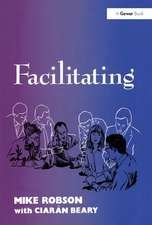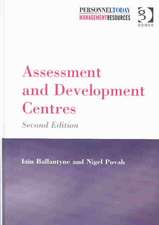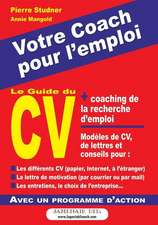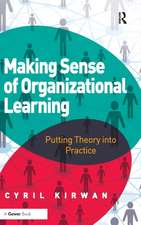Improving Learning Transfer: A Guide to Getting More Out of What You Put Into Your Training
Autor Cyril Kirwanen Limba Engleză Hardback – 18 feb 2009
| Toate formatele și edițiile | Preț | Express |
|---|---|---|
| Paperback (1) | 233.98 lei 6-8 săpt. | |
| Taylor & Francis – 24 iun 2024 | 233.98 lei 6-8 săpt. | |
| Hardback (1) | 764.20 lei 6-8 săpt. | |
| Taylor & Francis – 18 feb 2009 | 764.20 lei 6-8 săpt. |
Preț: 764.20 lei
Preț vechi: 1027.40 lei
-26% Nou
Puncte Express: 1146
Preț estimativ în valută:
146.23€ • 153.08$ • 120.100£
146.23€ • 153.08$ • 120.100£
Carte tipărită la comandă
Livrare economică 05-19 aprilie
Preluare comenzi: 021 569.72.76
Specificații
ISBN-13: 9780566088445
ISBN-10: 0566088444
Pagini: 222
Dimensiuni: 174 x 246 x 18 mm
Greutate: 0.45 kg
Ediția:1
Editura: Taylor & Francis
Colecția Routledge
Locul publicării:Oxford, United Kingdom
ISBN-10: 0566088444
Pagini: 222
Dimensiuni: 174 x 246 x 18 mm
Greutate: 0.45 kg
Ediția:1
Editura: Taylor & Francis
Colecția Routledge
Locul publicării:Oxford, United Kingdom
Notă biografică
Dr Cyril Kirwan is an experienced management and organisation development consultant. Before setting up Cyril Kirwan & Associates in 1996 he worked for many years in the airline and financial services sectors. He now designs and delivers interventions in areas such as management development, leadership and change management, learning and coaching for clients in a variety of industries in both private and public sectors. He holds a M.Sc. in Work and Organisational Psychology from Dublin City University, and a Doctorate in Business Administration from Henley Business School. He is a certified management consultant (CMC), a member of the Irish Institute of Training and Development (MIITD), a Chartered Fellow of the Institute of Personnel and Development (CFIPD) and a Visiting Academic Fellow at Henley Business School.
Cuprins
Introduction; Chapter 1 Learning and Learning Transfer; Chapter 2 Getting the Programme Right; Chapter 3 Bridging the Gap; Chapter 4 Getting the Work Environment Right; Chapter 5 It’s up to You: Making it Happen; Chapter 6 Dealing with Resistance; Chapter 7 Measuring Learning Outcomes; Chapter 8 How to Improve Learning Transfer;
Recenzii
'...In this well organised and practical book, learning providers, those charged with organizing training, and managers will all gain an understanding of the role they play in contributing to successful learning transfer. As a provider of learning and development interventions for more than 20 years, it gave me new insights and practical steps to take away. Kirwan brings together up to date research to support sensible recommendations...From doing a training needs analysis to measuring learning outcomes and all steps in-between, this is a handbook that will become a well thumbed reference for those who care about value for money and real workplace learning.' - Mary O'Rafferty, Director, Leadership and Management, Institute of Public Administration, Dublin 'Dr Kirwan candidly challenges the traditional learning and development mindset. His straightforward and well researched techniques will help training and learning departments demonstrate what tangible difference training is making to their organisation. With clear insights into what blocks learning transfer, he also provides pragmatic methods to maximise the return on investment from training and development programmes. This is a book for HR professionals, those responsible for L&D, and CEO's who are more interested in outcomes, than outputs.' - Hamish Brown, CEO, Concordia International Ltd '"Sometimes I feel that all those trainings and seminars we send our people to are just a waste of money, an HR-Manager told me only recently. And to a considerable extent I agree to it. Simply sending people to courses, only because the programme sounds interesting or - worse still - because some competitors go for the same kind of training, makes little sense. What is needed to have a return on investment into HR is shown in the book Improving Learning Transfer. Cyril Kirwan is a true practitioner and this shows in every line of his work. Thoroughly and systematically he identifies what makes the difference b
Descriere
Cyril Kirwan's book addresses this critical issue at a number of levels. Firstly, it explores what learning transfer actually is (it's about application of learning back at work, as well as maintenance of that learning over time). Secondly, it describes the main factors that affect transfer, in terms of trainee characteristics, training design factors, and work environment characteristics. It also examines how those factors exert their effect, which ones are more important, how they interact with one another, and in doing so constructs a practical learning transfer model for practitioners. The book also describes in some detail what the various factors working for or against learning transfer look like in practice. Finally, using case studies, it points the way towards what can be done before, during and after training to improve the rate of transfer.






















